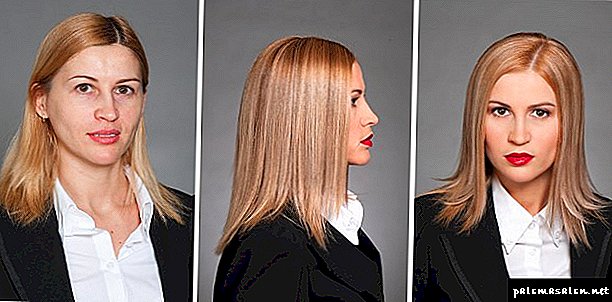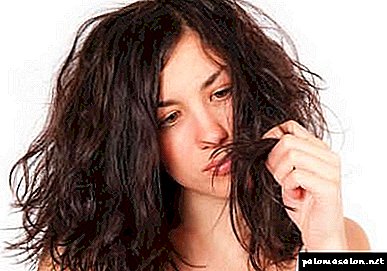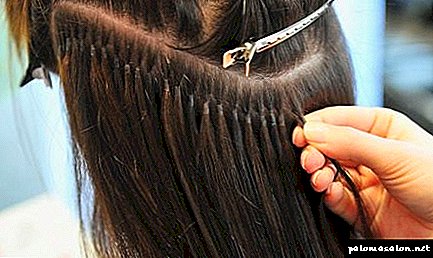
Extensive hair helps girls, and sometimes men to achieve the length and density of hair that you like. However, in order to always look fresh and beautiful, as well as to preserve the quality of natural hair, it is necessary to periodically carry out the correction procedure and change the accreted strands.
When to go to the master for the correction of hair extension: price for quality
Understand that it is time to go to the master, you can on the following grounds:
- Hair industry a few centimeters.
- Some strands have moved out, attached tapes or capsules are at different levels.
- The hairstyle has lost its finished appearance, the volume is distributed unevenly on the head.

The correction procedure consists of several simple steps:
- First, remove the strands on the head. To remove them, use a special remover or spray, depending on the type of capacity.
- Then prepare the client's own hair. They need to be carefully combed, cleaned of residues of glue, remove hairs that have fallen during the time of wearing the curls. If there is a need, tint the roots and adjust the haircut.
- When the curls are prepared, the already used strands are re-fastened on the head, using fresh adhesive. If the client has straight strands, then only Slavic hair is used for building up and subsequent correction of the extension hair. Unlike Asian, they are less prone to the formation of waves and easier to lay. Such strands are ideal for girls of Slavic type of appearance.
Proper care and washing of artificial strands by means of capsules
It does not matter whether the curls were enlarged by the capsular method or fastened with ribbons, the care will be the same in both cases.
The first thing to do after an additional volume has appeared on your head is to purchase special products for the care of the increased curls.
Shampoos, nourishing creams and sprays will provide them with softness, ease of styling, eliminate electrification and allow for a long time to serve their mistress.
It is better to give preference to the products that are sold in professional stores, or consult the builder and take advantage of his advice.

When caring for locks try not to wash them too often. The procedure for washing the hair is better to hold in an upright position, without dropping his head down.
In order for the attachment of the strands to be better preserved and a new hair correction is not required, it is desirable to dilute the shampoo with water and use soft, neutral products.
Do not wash under too hot water and carefully rub your head. Handle the strands with care. Caring agents should not fall on the attachment points.
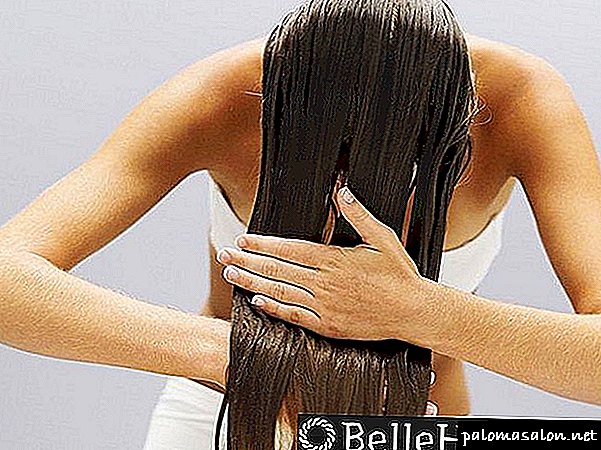
You can not apply to the extended strands of products for dry scalp and use hot air for drying, it is better to give preference to natural drying.
Hair styling and coloring
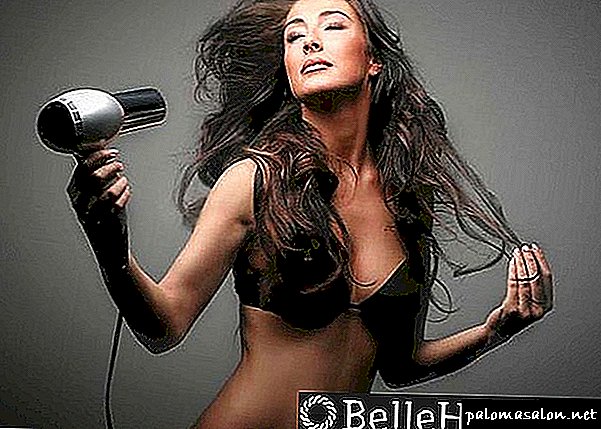
It is better to carry out coloring of artificially acquired strands in the cabin, or by using outside help, as the procedure requires special care: the coloring composition should in no case be taken to the place of attachment of curls.
The most correct decision will be to choose the desired hair color before the procedure or when the next hair correction after the extension will occur. This option will allow to avoid staining of already extended strands, which will adversely affect their condition, because the hair is deprived of the ability to feed off the body and suffer from such procedures much more than their own.
You can purchase strands of the appropriate shade and dye your own hair before extensions, so that they are indistinguishable from pasted ones.
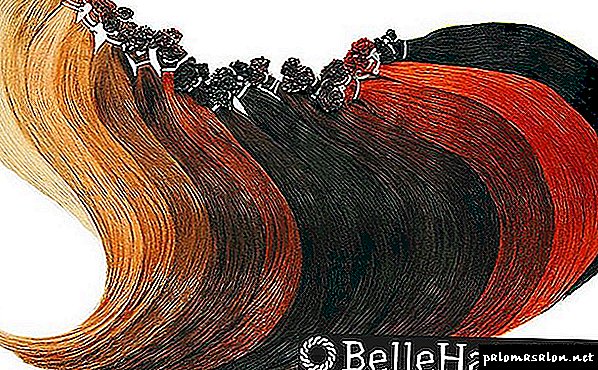 Today there is a huge selection of strands that can be matched to the color of their hair.
Today there is a huge selection of strands that can be matched to the color of their hair.
You can style your hair in the same way as your own. It is only necessary to acquire sparing means for creating hairstyles and remember that hot streams of air or red-hot forceps should not touch the joints of the strand with their own curls.
Correction cold build
- First, the hair is completely removed. Be sure to composition for removal of cold buildup, special tweezers and comb for untangling hair. Each capsule is treated with the composition and carefully destroyed with tweezers. The strand is tightened and laid aside. Thus we remove all strands,
- We wash with deep cleaning shampoo to wash off the remnants of the capsules, composition, hair grease, etc.,
- Dry hair
- We increase the same hair, the encapsulation occurs in the process of extension.
Hot build correction
- As in the case of cold build-up, first we completely remove the strands. This requires a liquid for removing hot build, tweezers, and a comb for untangling. Each strand is carefully removed, hair folded to the side, we will increase it later,
- My head for getting rid of the composition for removing hair extensions, pieces of keratin, etc.,
- Dry head
- We encapsulate the strands for a new build,
- We increase strands.
On average, cold build correction lasts 5 hoursWell, the hot one is a little longer, since it requires re-encapsulation of donor hair. The hair with which I work has no expiration date, so you can make a correction with them before
as long as you are satisfied with the length. But with each correction, the hair becomes 1 cm shorter, because when removed from the strand, the destroyed capsule is cut off. Correction does not harm your hair in any way, if you don’t wear it and take care of it during the socks.
3 stages of hair correction and care for enlarged strands
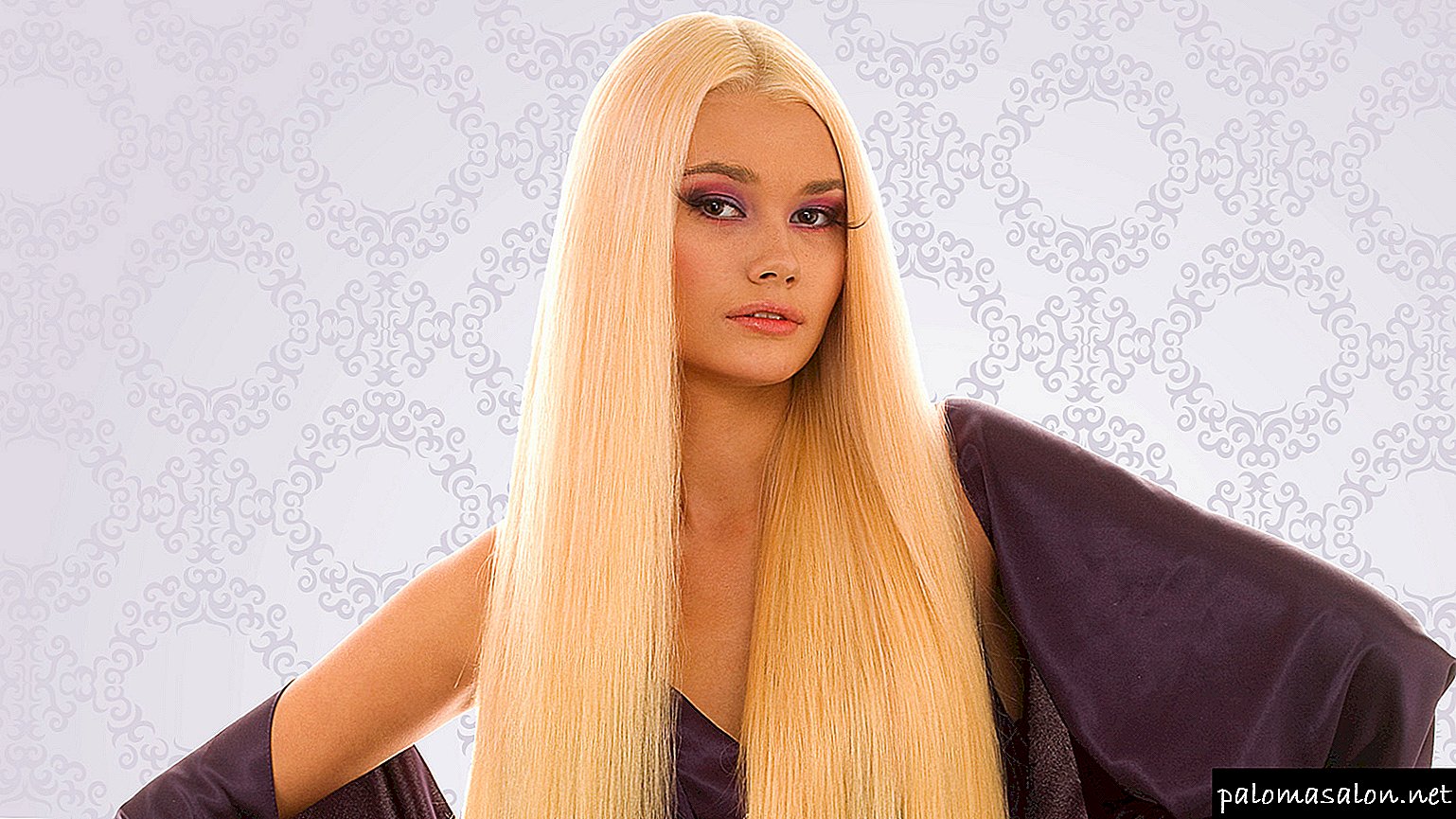
Over time, the hair on which the extensions were attached grew back, which leads to the need to adjust the location of the extensions.
Correction of extension hair is necessary to maintain the natural look of the hairstyle. The frequency of its implementation depends on how the buildup was carried out.
If your hair grows quickly, then the need for correction of extensible hair may occur monthly. In other cases, with other people's strands, you can walk up to three months.

Correction of tape hair extensions is carried out twice as often as a similar procedure for capsular material. The longest is to walk in curls attached to the Italian micro-capsular way.
How to do the correction of hair extensions
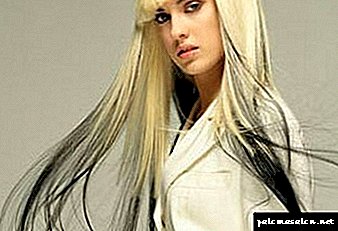
First, a special solution is applied to the hair, designed to dissolve the capsule and moisturize your own hair. Then the master with the help of special forceps breaks the capsule and begins to carefully remove the accumulated strands. Then they are washed, dried and cut the ends where the capsules were. At the same time wash your head.
To do the correction of hair extensions begin with the bottom row up. If this is a hot buildup according to Italian technology, then a new keratin capsule is soldered on each curl with a correction. Then it is placed under its own curl and heated with the help of special tongs. In this case, the master should make a flat or rounded curl of your choice.
If the English technology was used for hair extensions, the artificial strands are placed under your curls and glued with resin using a special gun. It is difficult to dose the resin and the capsules can be different in size.
If the build-up was done using cold technologies, when correcting the hair, new cutings are put on the strand or a new polymer is applied. At the same time, the removed strands remain in the same place, only they move closer to the roots.
To hair extensions had a beautiful look, carefully look after them, following the advice of a specialist. Do not forget that only well-groomed hair can be increased again after removal.
How do correction of hair extensions
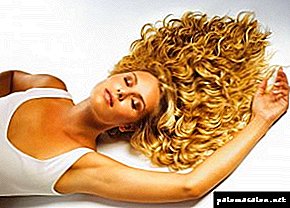 The hairs that are made up in the salon truly look great! But you must be prepared to provide them with appropriate care. From now on, hair care will include not only special masks, balsams and shampoos, but also a correction.
The hairs that are made up in the salon truly look great! But you must be prepared to provide them with appropriate care. From now on, hair care will include not only special masks, balsams and shampoos, but also a correction.
Artificial, extension hair is attached to the girl's native hair at a short distance from the roots. As your own hair grows, the non-native strands fall down, and the hair becomes unsightly and the original beauty is lost.
In order to give the hair an attractive appearance and external volume, non-native hair must be reattached above. This procedure is called "correction".
There are two main technologies for hair extensions: hot and cold
Includes Italian and English technology. In both cases, the extension hair is fixed with capsules, keratin according to Italian technology and a resin capsule according to English.
The correction process is as follows:
- A special solution is applied to the capsule.
- The capsule is heated by forceps, which makes it soft
- The stained strand is removed from the shattered capsule.
- The base of the extension strand is trimmed and then fixed on the hair again.
The duration of the procedure reaches 2 hours.
Cold methods include Japanese, Spanish and tape extensions:
Spliced strands are fixed with two-component glue. At correction glue collapses with the help of a special composition. The subsequent procedure looks similar to the hot method, i.e. the base with glue is cut off, and then the hair is fixed again on the hair.
When the Japanese build-up strands are fixed with metal-ceramic rings.
During correction, the ring is unclenched with forceps and the strand is removed. In the future, the donor strand is fastened with a new ring. Correction is performed after 3 months.
Tape extension is the fastest and therefore the most popular extension method. This method uses hair on a glue base 4 cm wide.
In case of correction, a special compound is applied to the fastening zone of the extended strands, which acts for a few seconds, after which the strands can be removed. Then the hair is washed, dried and increased again. Donor hair can be used 5-6 times, the correction is carried out after 2 months.
There is no unequivocal answer to this question. - after all, all girls have different hair growth rates. However, if your own hair has already grown 3-4 centimeters, then the correction is already necessary.
Remember that combing the hair near the roots is not recommended - in order to avoid tangling of hair and other troubles. With the timing of hair correction is better not to delay. The approximate frequency of hair correction - once every 2-4 months.
Of course, you can take off other people's strands and never make a correction again. However, if you like to be puffy-haired, then you can not do without correction.
Duration of wearing hair depending on the type of correction:
- Keratin buildup - 1-1.5 months (quality materials can increase this period up to 3 months)
- English capacity - up to 4 months
- Spanish build-up (adhesive build-up) - up to 6 months with correction after 3 months
- Japanese - after 3 months
- Tape building - correction every 2 months
- Ultrasound extension - after 4 months
During the correction procedure, a part of alien hair will become unsuitable, and this missing part of hair is recommended to be replenished in order for the volume of your hair to be the same.
After correction, the length of your hair may become shorter by 3-5 centimeters. However, luxurious hair will allow you to continue to feel irresistible!
How often to spend?
The correction procedure is that the donor strands in the head of hair are removed and then attached again to natural hair. This is done because in 2-3 months, during which there were accrued curls on your head, your hair grows, and the distance between the scalp and the “donor” locks increases.
Capsules are tangled in the hair, hairstyle takes on a sloppy look. To avoid such trouble and carry out a corrective procedure.

How often does it have to be done? Of course, you can focus on personal characteristics: for example, all hair grows at different speeds, if one girl may need correction after a month and a half, the other calmly walks with curls and 3. But there are other nuances that are worth paying attention to, namely:
- extension technology
- features of the care procedures.
If you have hair extensions using one of the capsule methods, it is recommended to make a correction every 3 months. When using tape building - once in 1.5 months. But again, these are all recommendations, not rules.
Look at the state of hair after a month, two, three and build your own schedule for the procedure of correction.
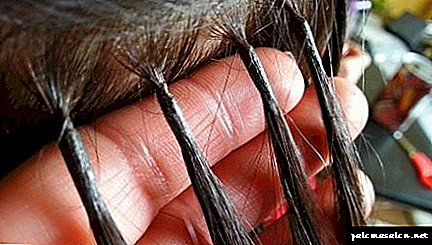
Italian technique
To begin with, each microcapsule is processed by a softener - a remuver, for its destruction. Next, the stylist takes the forceps, squeezes the microcapsule and splits it. The donor strands are disconnected from the hair, and keratin particles are removed from them. After this, the preparation of hair begins to build. Natural curls are combed, cleaned of keratin particles, thoroughly washed with shampoo-degreaser.
If necessary or desired by the client, carry out painting or cutting.
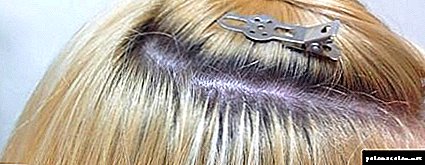
By the way, at this stage, the specialist may advise for some time to refrain from building up to restore the quality of natural hair. If the correction procedure is still carried out, keratin “droplets” are applied to the donor locks and fixed to the head of hair by heating and pressing with special forceps. By the time of removal of the microcapsules can last about an hour, and holding the second procedure of building - 2 hours or more.
Spanish technique
This hair extension without heat exposure: strands are attached to the hair on a special glue. The correction is done like this: with a solvent-remover, the joints of all the “donor” curls with natural hair are processed. When the glue dissolves, its remains are combed out of the head of hair, washed thoroughly, dried, glued again. This procedure lasts about 60 minutes.
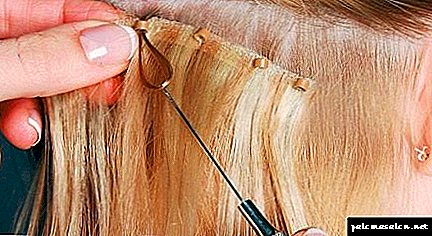
Tape technique
If you have extended your hair with ribbons, then the procedure will be as follows: with a spray containing alcohol, the specialist sprinkles the ribbons and carefully removes them, removes the remnants of the old tape from all the donor strands, and sticks a new one. The hair is washed and dried, and then it is curled with new adhesive tapes. As a result, they are removed for about 30 minutes, increased anew in an hour and a half.

African technique (tress)
Hair extension by this technology involves weaving a braid “basket” of natural curls and stitching to it in a circle of tresses. The correction procedure consists in detaching the old material from the head, unraveling the scythe, washing and drying the hair. Then a new “basket” is woven, to which the master sews new tresses. This whole process lasts about 2 hours.
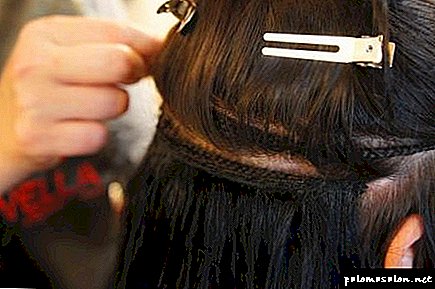
Brazilian method
It is similar to the African one, but it consists in weaving the strands, and not in sewing them. When carrying out corrective procedures, the curls just interlace closer to the hair roots. By the time it takes 2-2.5 hours.
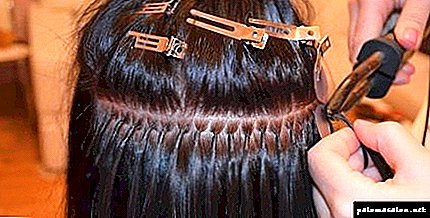
Professional Tips
In order to prolong the life of your hair extensions, do not neglect the advice of professional hairdressers and stylists.
- Never go to bed with undressed hair. This contributes to the appearance of tangles and pulling out curls when combing.
By the way, you should comb only dry hair.
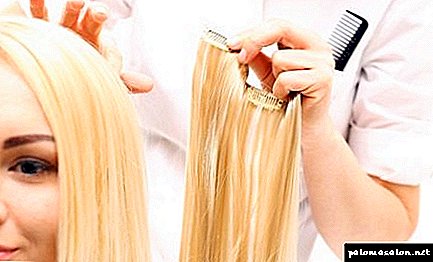
- When carrying out the shampooing procedure, do not keep the products (shampoo, mask, conditioner) on the hair for more than a minute. Microcapsules under their influence are softened and the strands “donors” can simply “slip”.
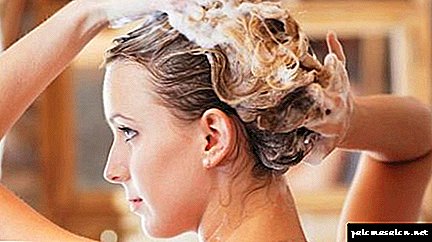
- When blotting your hair with a towel, move from top to bottom, do not pull the curls, do not rub hard or twist.
- Brush gently 2-3 times a day, from the ends of the hair to the roots. This will avoid the appearance of nodules and mats in the future.
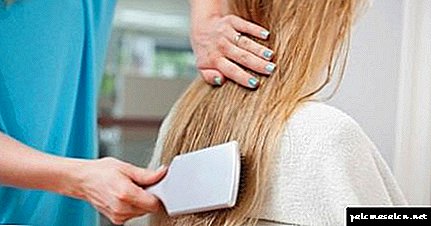
On the correction of hair extensions, see the following video.
Studio hair extension Gloss Hair & Brow in Yekaterinburg

Correction of hair extensions in Yekaterinburg, you can do in the studio hair extensions Gloss Hair & Brow.
Correction build-up is a procedure to re-build the strands.
The same strands are used: first, they are removed, and then attached again to natural curls.
Correction must be done necessarily! Native hair grows over time, accrued strands descend, the boundaries between them become noticeable, as a result, the hairstyle loses its original appearance.
How often do you need to make hair correction?
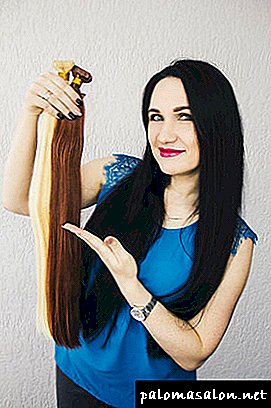
To hair extensions look natural and natural, the correction should be done on time.
The frequency of this procedure depends on several factors:
✔ features care for extended strands,
✔ growth rate of their hair,
✔ length and density of native hair.
If your hair is of medium density, it is enough to carry out the correction once every 2-3 months.
If you have very thin and sparse hair, or the length of native hair is less than 10 cm, you need a correction once every 1.5-2 months, because under the weight of your hair, your native hair will start to grow together very quickly, stretch out.
Determine that it's time for correction simple enough.
If the native hair after the procedure of building up the industry by 3-4 cm, the ribbons began to interfere with the hair, then it is time to sign up for the correction.
Stages of correction of hair extensions.

1. Removal of hair extensions.
Correction always begins with the removal of accreted strands. Removed tape building without difficulty. The wizard processes the strand with a special liquid safe for your hair and removes the strands quickly and painlessly.
Important. Your own hair loss after removal! On the correction or when removing you see those hairs that fall naturally in the process of wearing. After all, for the period of 2-3 months before the correction, they cannot disappear from the tape anywhere. When removing the hair is not injured and, accordingly, do not fall out.
2.Preparation of native hair.
After removing the hair extensions native curls need to be put in order. It is good to comb them with a special comb with fine teeth. Remove tangles, loose hairs, as well as residual glue.
3. Preparation of tape hair.
Old tape is removed from the tapes. Master puts new glue strips-kuttingi.
With proper care for hair extensions and timely correction, the same strands can be reused and worn for an average of 6-18 months (The very hair strand of Gloss Hair can tolerate 6 or more corrections). During correction, only cutouts and the work of the master are paid.
4. Repeated increase.
Once your hair and overhead strands are in order, you can proceed to the standard procedure of building. With the help of new adhesive strips, strands of ribbon hair are again connected with the client's native hair.
In this case, the build-up occurs approximately in the same area of the head, but slightly moving up or down. Thus, some of your natural hair rests from building up, while others take the burden.
Each time at the correction, the master changes the area where the strands are growing. From here you can make a conclusion that tape extension does not harm your native hair at all; they are not overloaded.
During the correction, the master performs triple work. Therefore, the cost of correction is slightly higher than the cost of work for the initial build-up.
How much time does the correction take?
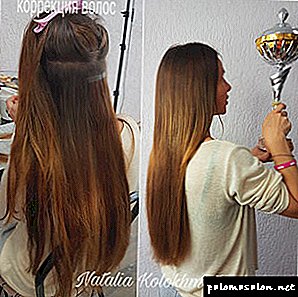
Correction tape extension is very fast (Regarding capsular hair extension). And this is with a huge amount of work!
Only 30 minutes for 20 tapes or half volume.
1 hour for a standard volume of 40 tapes.
If 60 tapes are used, the correction time will be 1.5 hours.
But. With the formation of tangles or tangles, the operating time may increase by 1–2 hours depending on the complexity and degree of tangled hair or hair extensions.
Matted hair is NOT NORMAL. This is the result of non-compliance with certain rules of hair care.
Attention!! Dispel the myths !!
After complete removal of hair extensions, you will definitely feel that your hair has become less.
This is normal. During the time of wearing the hair, even if you walked with them for only a couple of months, you will get used to the large density. And after removing the loss of any volume accrued will be noticeable. But, after a maximum of a week, the feeling that their hair has become very little passes.
You get used back to your hair volume.
If you want your hair to look flawless after the extension, the timely removal and correction of hair extensions can extend their life. This will help to preserve their volume, beauty and well-groomed appearance for a long time.
It is necessary to entrust the procedure of extension and hair correction, as well as removal, to a professional. In Yekaterinburg, the correction or removal of hair extensions can be done in the studio of Gloss Hair & Brow from a master with vast experience of more than 10 years Natalia Kolokhmatova.
We will carry out the correction at the highest level, with a guarantee of impeccable results and high quality of the work performed!
Hair Care
Regardless of whether hot build-up or cold was used, the technology is the same: stackable donor strands are attached to the natural on a special capsule. This means that it is necessary to treat the hair as carefully as possible, since it is possible to damage or even detach the capsules, which will significantly ruin the hairstyle. Therefore, there are certain rules for handling hair after the procedure of building.
For combing you will need a special comb for hair extensions, which is made of soft bristles. This special bristle with a sufficiently gentle combing reduces the risk of damaging the capsules to almost zero. Regular combs made of hard materials such as plastic or wood can cause significant damage to the hair, so you should give them up. It is best to comb the head of hair, starting from the tips and ending with the roots, adding hair to the tail free from the comb. This procedure should be carried out at least 3 times a day to avoid tangling and the formation of tangles at the place of attachment of the strands, special attention should be paid to the roots - the places of attachment of the capsules, since they are likely to be tangled. Do not comb wet or wet strands - it hurts and native, and donor hair.
There are several rules about going to bed:
- Sleeping with loose braids is not recommended so that they are not confused. The best way out is to braid them before going to bed in a free, loose braid, or put them in a tail with a soft rubber band.
- Sleeping with undrained or wet strands is strictly prohibited.
Hair styling also requires compliance with some rules:
- For laying it is quite acceptable to use thermal technology - a hair dryer, tongs, hair curlers, ploies, irons, but it is strictly prohibited to affect the bonding places of native and donor strands,
If the hair is still tangled, then in no case should you try to solve this problem on your own, as this will only aggravate the situation and you will have to completely abandon the extensions. Only a barber specialist who has a special technique for working with tangled extensions can help this.
Spiked hair is easily damaged or tangled, there is also a risk of damaging the capsule attaching additional hairs.
It is worth remembering and following some rules for washing extensible hair:
- Before washing the head it is necessary to carefully comb the strands so that they do not mess up in the process of washing,
- Water should flow down through the hair, so it is best to do it under the shower. If you throw your head back or lean forward, the hair may be tangled,
- The frequency of washing is no different from the usual, that is, it is worth washing your hair as it gets dirty. But it is better not to wash your hair more often 3-4 times a week to avoid drying out natural hair,
- Masks, conditioners, balms should be applied to the ends of the strands and their middle, but in no case, to the attachment points,
- What to take shampoo? The best option would be a pH-neutral shampoo for normal hair with a low concentration of active substances. It would be great if the shampoo includes moisturizing ingredients. It is worth paying attention to the fact that shampoo designed for fatty types will dry out the donor strands, and shampoo for dry hair can provoke their loss due to the action of the softener. It is also forbidden to use shampoos that increase the volume, as when lifting the cuticles (and this is the main function of the shampoo with an increase in volume), the hair will tangle,
- It is better to dissolve an excessively thick, pasty shampoo with water to a more liquid state, the same applies to other care products,
- The shampoo should be easily and gently spread on the hairline, and not rubbed in order to, again, avoid tangling,
- You need to wash your hair in cool or warm water with gentle massaging movements, never rub your hair,
- Hard and chlorinated water will ruin the strands,
- After washing, you need to gently wet the hair with a towel, in any case not to rub,
- It is better to dry the head after washing in a natural way, although the use of a hair dryer is allowed - the main thing is not to direct the stream of hot air to the bonding places and not to dry at the maximum hot mode
Is it possible to dye the hair extensions
It is best to color the hair before building it up, but already extended strands may require color correction.
You can paint them, but it is worth remembering a few important details:
- Regrown roots of a natural color, different from the color of donor strands, should be colored when the hair grows so that the capsules attaching the strands are removed from the scalp to the desired length,
- Donor strands that are directly enlarged can be dyed, but some types of hair cannot be colored or behave unpredictably. First of all, it concerns artificial strands, which, after dyeing, can fall into an inseparable mass. It is impossible to dye bleached or Asian hair - in principle, they cannot be colored due to the treatment with a special chemical composition,
- Only ammonia-free paints can be used.
- The donor strands of European or Slavic type can be painted,
- You can not lighten the hair extensions, you can adjust their shade or make them a few tones darker,
- In no case do not do the dyeing yourself, this can only be trusted with a professional hairdresser,
- It is strictly forbidden to allow the coloring matter to enter the capsules,
- It is best to carry out a correction together with staining.
Extension hair correction
Extensive hair requires regular correction, as relatives grow, capsules are removed from the scalp, and in this regard, the hairstyle looks much worse, hair is also confused, and there is a likelihood that the capsules will be visible to prying eyes. It is also worth considering the factor that the build-up prevents the removal of naturally fallen hairs (up to one hundred hairs per day), which remain in the capsule and tangle with live and hair extensions. The correction procedure should be carried out at least once every two to three months.
Stages of correction of hair extensions:
- At the first stage of correction, the capsules are removed and the subsequent combing out of the dropped out hairs with a comb with frequent, fine teeth. Capsules are removed using a special liquid, softening or dissolving capsules,
- The second stage of the correction is called “overcapsulation”. It consists in removing old capsules and planting donor strands on new capsules. New capsules are always used, as the old ones are becoming unusable. Capsules are formed on site with the help of special forceps,
- The third stage is the build-up itself, which is absolutely identical to the original build-up procedure.
It is worth considering that the length of the hair decreases after the correction. The range of change reaches 3-5 centimeters. During the correction, it may be necessary to replace the damaged strands or add new strands, since up to 20% of the extensible hair may be lost during the wearing and correction. It is strictly forbidden to take off the stretched strands independently or carry out the correction; you can get rid of them at home only by cutting the donor strands together with your own.
The whole procedure of correction lasts up to five hours, it is absolutely painless.
Keratin buildup:
When using cheap materials, it will be possible to enjoy a new hairstyle not for long - from one to one and a half months, then the hair will lose its “presentation” and you will have to make a correction. This option is most suitable for creating a new hairstyle for a celebration, a specific significant date or for a short time as an experiment. When using high-quality raw materials, the time for wearing hair is longer - about three months, then the same correction will be needed.
How to remove hair extensions
Removal of hair extensions is both an independent procedure for the final rejection of the hairstyle, and an intermediate stage during the correction.
The extensions have their own life, which is worth paying close attention and not delaying with the removal or correction. This is due to the fact that the hair between the scalp and the capsule itself cannot be combed qualitatively, in connection with this non-entangled tangles can be formed, which in particularly advanced cases can only be cut, and the correction or removal of hair entangled at the root will cost several times. more expensive than normal.
Removal of extended strands is performed with special tongs using an active solution, softening capsules - gel or liquid. But the details of the removal are directly dependent on the method by which the build-up was performed.
Hair removal is highly undesirable to carry out at home, as there is a high probability of severely injuring the native curls. Yes, and liquid for removal of hair extensions (which is designed for reusable, rather than a one-time use) will cost more than going to the salon.
How often and why do I need to make correction of hair extensions?
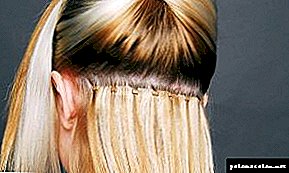
Each person has his own individual hair growth rate, and therefore the question “how often?” Must be approached from a strictly individual point of view. Between the procedure of the first extension and hair correction with proper care takes about three months. But there are situations when the correction procedure should be carried out more often: for example, when the girl's native hair curls heavily. Then, when wearing extended strands for a long time, they can become very tangled. To prevent this, the correction will have to be done more often - but native hair will not suffer.
If strands with special capsules managed to grow by 3-4 centimeters, the girl just time to go for a correction.It is important to remember that natural hair above the capsules, which in the natural conditions of life can easily fall out and be combed, after the procedure, as a rule, remain in place in the capsule. Therefore, if you do not make the correction in time, this hair can be very tangled, cause unpleasant sensations on the head, and even provoke trauma.
How is the hair correction procedure done?

Correction takes much more time than the building itself. The correction includes four main stages:
- hair removal
- carefully re-encapsulating them (namely, replacing old capsules with new ones),
- stage of putting the capsules in place
- next is an ordinary build-up.
- To start, the master will hold hair removalFor which special hairdressing nippers for removal and professional liquid will be useful. Hairdresser works with each strand separately. Separately, liquid is applied to each strand so that the capsule holding the donor hair is softened. The keratin structure of the capsule under the action of fluid and special forceps is destroyed and becomes dust.
- Then the specialist carefully holds the strand of natural hair from above, and with the other hand carefully and carefully pulls down the donor hair. The hairdresser will carefully comb the remnants of keratin on the natural surface of the hair, hair that has fallen out during the wearing of the strands or any other intricacies with a special comb with rare teeth.
- After the removal process comes to an end, the master proceeds to a gradual re-encapsulation, and also prepares the hair for extension. The old capsule, which was used for extension, is no longer suitable for use, because it is cut off from the donor curls already removed. Specialist build-up creates a completely new keratin capsule, after which the hair is completely ready for the procedure of a new build-up.
- Next, the hairdresser proceeds to the most common procedure extensions. On average, this process can take from 4 to 6 hours, depending on the degree of hair confusion and the total number of strands that the client wants to increase. Timely correction will increase the time of hair wearing and save hair from damage or loss.
Where do the correction?
Any girl wants her luxurious curls accrued as long as possible remain beautiful and well-groomed. In this case, it is important for her to remember that the time taken for removal and correction will help to extend the life of the false hair and preserve its fresh, luxurious and healthy look for a long time. For this purpose, the build-up procedure should be trusted only to true professionals.
In the best salons of large cities of Ukraine and Russia, hairdressers work with years of experience, who work at the highest level with a guarantee of excellent quality. Now the procedure for correction can be made in the following Ukrainian cities: Kiev, Dnipro, Kharkiv, Nikolaev, Odessa and Cherkasy. A lot of Russian cities at the present moment offer services for the quality correction of hair extensions. Among them I would especially like to mention the salons of Moscow, St. Petersburg, Sochi, Penza and Korolev.
How much is the correction of hair extensions. Price
It should be emphasized that the cost of the correction of hair extensions will vary greatly depending on the specific beauty salon, professional and the city in which the correction will be made. As a rule, in the capital, the cost of such a procedure is much higher. In addition, the applied type of build-up and the number of strands that need to be corrected will affect the price of correction. On average, in Ukraine such a cost ranges from 600 to 2000 UAH, and in Russia - from 4,000 to 10,000 rubles.
Correction of hair extensions is an important procedure for the care of donor hair, on which will depend not only the beauty of artificial strands, but also the health of native curls. Therefore, it is important to contact a specialist in a timely manner.


